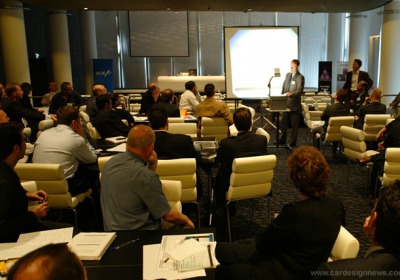Second annual ENG Automotive Design Summit held in Rome
Wed, 09 Jun 2004 European Networking Group (ENG) held their second annual Automotive Design Summit May 12-13. To follow on from the success of last years event in Barcelona, the event was held in the stylish Es Hotel in Rome, Italy. The event featured workshops sessions and business case studies from some of the most renowned designers in the industry, seeking to bring both knowledge and inspiration to the participants over the two day event.The focus of this years event was on creating a competitive advantage through designing exciting, compelling vehicles while communicating brand identity, reducing time-to-market, exploring new trends and stimulating creativity. The summit is the industry?s only event of its kind, with presentations from some senior industry figures to over 80 delegates. Some of the highlights from the summit presentations included:
Stefan Sielaff (director design interior competence centre, Daimler Chrysler) began his presentation by saying how a car's exterior is love at first sight, but the interior is where a lasting relationship is formed. He then explained the significant impact on design of the brand's extension into new product categories and its proliferation of variants with each model, and how the newly introduced values of the Mercedes-Benz design identity would be used whilst maintaining the vertical and horizontal homogeneity expected from the brand.
Roberto Piatti (managing director, Stile Bertone) made a refreshingly personal presentation that highlighted the issue of peoples' emotive connection with the car and how increasingly the ultimate WOW of this connection is missing in recent, typically conservative designs. He then suggested that the car today is still too much related to the myth of speed and that there is a need for a genuine step change in vehicle design innovation that might reflect this and adopt a role less as a means to travel between A and B and more as an extension of a home environment.
Andreas Wlasak (vice president industrial design, Faurecia) presented some fascinating future trends in interior design and also made a very salient observation that the growth in number of exterior typologies has not yet been reflected with such clear interior design differentiation between them ? an opportunity for future development.
Marek Reichman (director product and interior design, Lincoln) clearly relishes the task of taking a long established American brand and reestablishing its premium luxury position in the market whilst moving into a more modern idiom. Marek presented some of his perspectives on what constitutes modern luxury and specifically the Lincoln flavour of modern luxury.
Cynthia Charwick (senior automotive interior designer, Volvo) focussed on the design development process of Volvo's YCC (Your Concept Car), and as the most experienced designer on this all-women project, Cindy's story was unique and insightful. It was also valuable in impressing upon the predominantly male audience how the YCC design highlights the scope for a more inclusive design approach and should not be considered as 'just a car for women'.
Klemens Rossnagel (head of concept design Munich, Audi Brand Group) presentated the perfect closing speech as he put into a broader context so much of what had been said over the course of two day's fairly intense discourse, and yet also eloquently underlined how nebulous the practice of automotive design remains. Despite the frequent assertions that design is a major contributor to a brand's commercial success it has yet to mature to become as accountable or truly robust a discipline as it might; as Klemens said, sculptors are committed to themselves and the form. Today many car designers still behave this way.
Many other presentations and workshops from people including Michael Robinson of Fiat, Lorenzo Ramaciotti of Pininfarina, and Dale Harrow of the Royal College of Art also gave an interesting and varied insight into the pertinent issues facing the automotive design community.
But whilst this insight offers one of the main reasons to attend, the summit also provides a unique opportunity for designers to rub shoulders and recognise how unique this occasion was as a forum for discussion, development and reference within the industry. Perhaps next year's Automotive Design Summit shall develop further with contributions that are consistent in furthering the collective development of one of the worlds most important but under-nourished professional disciplines.
Related Stories:
2003 ENG Automotive Design Summit
By Sam Livingstone

